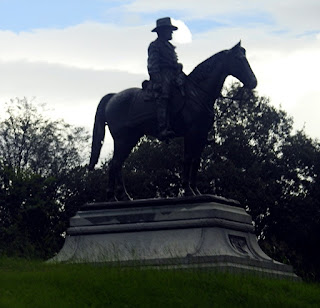96% humidity. Rob
opened the doors to the veranda this morning and everything was immediately
wet. Rob’s glasses clouded over. I was going to take a picture of him with his
opaque glasses but my camera lens was also opaque, wet and steamed up. And if you venture outdoors, you run between
squalls wearing steamed up glasses! Or
you can navigate by phone if you can see through the fog on the screen. People live here on purpose.
The mighty Mississippi River has a mind all its own. It meanders where it feels like it, creates
new channels on a whim, eats the shoreline or builds up sandbars. Despite this, humans have in large part come
to control this beast with locks, levees and walls. Several of the places we have visited have constructed
thick walls to fend off rising waters and they have been effective in saving
the cities. Flood levels are marked on
the walls, one read ~65 feet. Artists
have been engaged to paint murals on the panels. The one that stood out today was a depiction
of (President) Teddy Roosevelt on horseback escorted by his official
entourage. He had come to Vicksburg to
go bear hunting. In an ass-kissing
gesture, a bear was tied to a tree and Teddy was urged to shoot it. Shoot a bear tied to a tree? Teddy refused. The story took on a life of its own and
before long, “Teddy Bears” came to be.
 |
| Statue of General Ulysses S. Grant on the battlefield grounds at Vicksburg |
Vicksburg was deeply involved in the Civil War. Abraham Lincoln instructed his generals to
take Vicksburg at all costs. Vicksburg,
he said, is the key and until that key is in our pocket, we cannot win this
war. The city was the pulse of the
economy of the South, central to all shipping and their last stronghold.
Lincoln and Grant reasoned that, if they
could conquer Vicksburg and split the South in half, victory for the North
would be guaranteed. The South
understood this, too, and held onto Vicksburg like a pit bull with a sock. The battles were bloody and long and pitted
brother against brother: at one point on
the tour, we viewed the Michigan monument.
Here on the tour it was explained that half the Michigan soldiers were
Union, half were Confederate and many of them knew each other and some were
brothers. They would get together in the
evenings and drink and play cards and party together. The next morning, they would take up arms and
shoot at each other. At last, exhausted and
suffering from battle weariness, dysentery, yellow fever, typhoid fever,
malaria, pneumonia and starvation, the Confederacy surrendered at
Vicksburg. Gen. Pemberton surrendered to
Gen. Grant on July 4th, 1863. Vicksburg did not celebrate the 4th of July again until 1945. There is a Union burial ground at Vicksburg where 17,000 Union soldiers are buried. Thirteen thousand are unidentified. (Dog tags were devised much later, in 1911.) |
| Union Cemetery at Vicksburg Memorial Park |
In 1861, the government commissioned James Eads and
Company to build 7 ironclads (ships) for the war effort. Their mission was to steam up the river and
destroy Confederate batteries. On Dec.
12, 1862, one of these, the Cairo, was sunk by enemy torpedoes (mines) on the
Yazoo River near the battlefields at Vicksburg.
The ship sank in 12 minutes but none of the 251 crew perished.
 |
| Hull of the SS Cairo |
 |
| Starboard piston, paddle wheel and boilers - SS Cairo |
Animals often play a part in war. “Old Abe,” an eagle, was the mascot of the
Union troops from Wisconsin. He would
spread his wings and scream during the gunfights at many battlefields. He survived the Civil War and was a pampered
pet at the capitol building in Wisconsin until a fire broke out. Old Abe screeched and gave warning of the
fire but soon died of smoke inhalation. It
is said that the logo of the 101st Airborne was fashioned after Old
Abe as is their nickname, “Screamin’ Eagles.”
 |
| Old Abe atop the WI monument at Vicksburg Memorial Park |
“Familiarity breeds contempt… and children.” - Mark Twain
Another great blog!
ReplyDeleteOne of my favorite BBQ places is in Vicksburg, Goldie's.
love those historical pictures I think I was born a hundred years to late I think I would have loved living way back love the log . that is to much humidity for me thanks aain for the historic lesson
ReplyDeleteBeen there. You captured it eloquently as usual
ReplyDeleteThanks for helping us remember one of our most remarkable places! We so loved Vicksburg and you helped us remember that awesome history there!! Great blog my friend!!
ReplyDelete